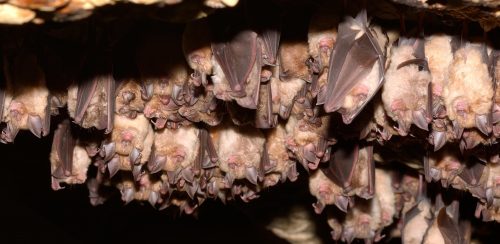Hidden Homes: Bats and Trees – by Katie Goldsbrough
Imagine a giant, gnarled, veteran oak, covered in cavities and crevices of all shapes and sizes, that have been created by snapped branches, draped ivy or woodpecker excavations. Now imagine a younger, slimmer, beech tree, reaching tall to the sky with multiple limbs, displaying loose bark, splits, gaps, and cracks across its whole form. A beautiful thought on a glum, typically English rainy day as I am writing this, but importantly, two iconic features in our beautiful British landscape that bats call home.
Now bats are not too fussy, and these are not the only two options of tree they will go for. They prefer oak, beech, and ash, but any tree will do if it hosts enough suitable bat-sized gaps. If you have never seen how a bat uses these spaces, it is quite a fascinating thing to watch. Bats like being compact, it makes them feel safe and cosy, therefore the smaller a space, the better. In fact, crevice dwelling bats can crawl into gaps as small as the width of an average human thumb to reach their roost!


Trees are useful to bats for two main reasons. Firstly, they are an accessible and comfortable place to roost, protected from ground predators and sheltered from the elements. Secondly, it is a fabulous place to forage for some dinner. Especially within a woodland or hedgerow, the abundance of insects is like a buffet at your doorstep. This choice of home is also useful for the different requirements that come at different times of the year. For example, in the summer when female bats need more warmth to raise their young (pups), they may utilise the tree in the higher canopy area. Or, when winter comes and the urge to hibernate kicks in, bats may move lower and deeper within the tree to achieve cool and stable temperatures, ready for their long winters slumber. These varying roost preferences may also change swiftly within the same season, depending on the needs of the bat at the time, such as finding water, predator avoidance or disturbance. Bats will also use trees for other reasons, such as feeding perches, short term protection during bad weather and even as a navigational aid to work out where they are in the landscape and guide their commuting routes.
All 17 UK breeding bat species have been found within or around trees, highlighting again the importance of trees to this incredible animal. Although bats have utilised human structures, trees are the original roosting favourite. Pipistrelles, Brown long-eared, Noctule, Barbastelle, Bechstein’s and Natterer’s are all species of UK bat that particularly rely on trees. The high value of woodlands and individual trees is ever increasing for bats, even more so with the changes in materials and designs of modern buildings and developments which are sadly creating less roosting potential for bats in urban environments. Bats such as pipistrelles and brown long-eared can be found roosting in houses, barns, and other buildings, but the 15 other UK species relying mainly on trees or bat boxes.
Bats love trees. Veteran trees, mature trees, young trees, dead wood, deciduous woodlands, coniferous woodlands, individual trees, hedgerows, basically any form of tree you can think of at some point in its life cycle, plays a vital part in bat ecology, whether providing a roost or supplying a food source of insects. Increasing our tree cover in England by creating new woodlands, hedgerows and planting individual trees is a great step in the right direction for expanding this vital habitat for all UK bat species. The correct, sustainable management and care of existing woodlands is equally, if not more important in the short term, to provide habitat right now and sustainably into the future. The variances of tree structures, species and ages is just as significant as the trees themselves for maintaining a suitable environment for not only this group of incredible species, but many others too.
If you want to find out more about woodland creation, current government grants for creating new woodlands or woodland management grants you can visit the Forestry Commission website here:
Forestry Commission – GOV.UK (www.gov.uk)
For information on good practice and guidance on managing woodlands with bats in England:
INTERIM GUIDANCE (bats.org.uk)
 Katie Goldsbrough, BSc, MSc
Katie Goldsbrough, BSc, MSc
Katie is a woodland officer in the Forestry Commission, covering the North Essex and Babergh area in Suffolk. She is a passionate forester with a background in wildlife conservation and ecology. In her own time, Katie is an ambassador for Essex Wildlife Trust and a volunteer for her local bat group, helping to care for and rehabilitate injured and grounded bats.
Blog posts on the CIEEM website are the views and opinions of the author(s) credited. They do not necessarily represent the views or position of CIEEM. The CIEEM blog is intended to be a space in which we publish thought-provoking and discussion-stimulating articles. If you’d like to write a blog sharing your own experiences or views, we’d love to hear from you at SophieLowe@cieem.net.
